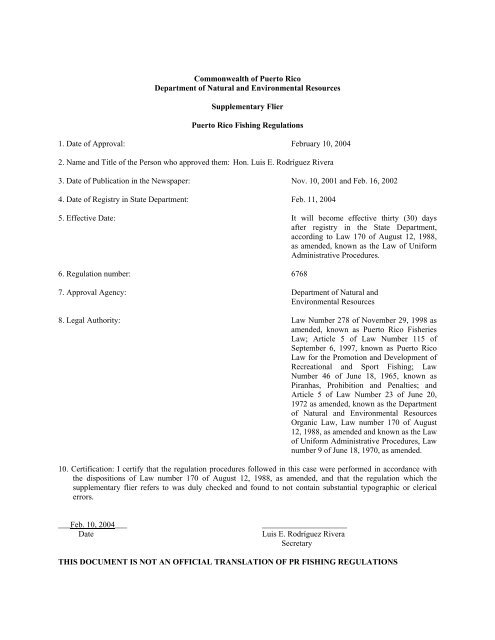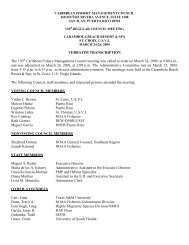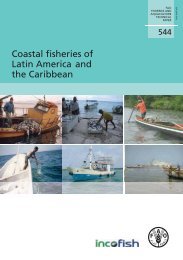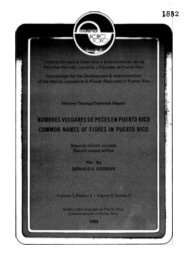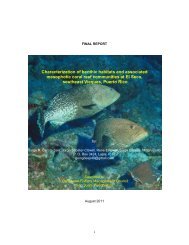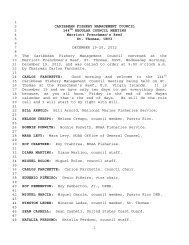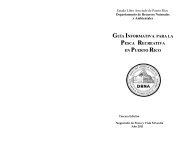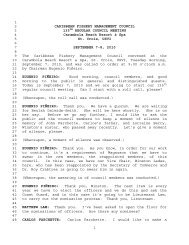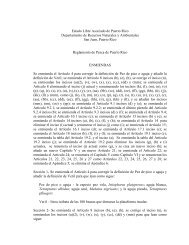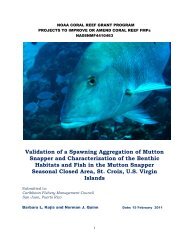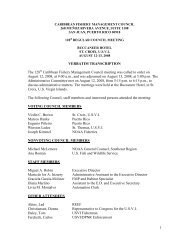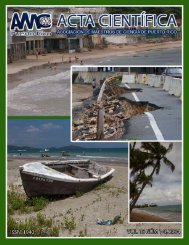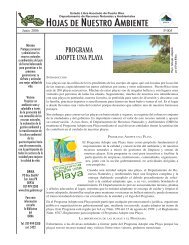Puerto Rico Fishing Regulations - Caribbean Fisheries ...
Puerto Rico Fishing Regulations - Caribbean Fisheries ...
Puerto Rico Fishing Regulations - Caribbean Fisheries ...
Create successful ePaper yourself
Turn your PDF publications into a flip-book with our unique Google optimized e-Paper software.
Commonwealth of <strong>Puerto</strong> <strong>Rico</strong>Department of Natural and Environmental ResourcesSupplementary Flier<strong>Puerto</strong> <strong>Rico</strong> <strong>Fishing</strong> <strong>Regulations</strong>1. Date of Approval: February 10, 20042. Name and Title of the Person who approved them: Hon. Luis E. Rodríguez Rivera3. Date of Publication in the Newspaper: Nov. 10, 2001 and Feb. 16, 20024. Date of Registry in State Department: Feb. 11, 20045. Effective Date: It will become effective thirty (30) daysafter registry in the State Department,according to Law 170 of August 12, 1988,as amended, known as the Law of UniformAdministrative Procedures.6. Regulation number: 67687. Approval Agency: Department of Natural andEnvironmental Resources8. Legal Authority: Law Number 278 of November 29, 1998 asamended, known as <strong>Puerto</strong> <strong>Rico</strong> <strong>Fisheries</strong>Law; Article 5 of Law Number 115 ofSeptember 6, 1997, known as <strong>Puerto</strong> <strong>Rico</strong>Law for the Promotion and Development ofRecreational and Sport <strong>Fishing</strong>; LawNumber 46 of June 18, 1965, known asPiranhas, Prohibition and Penalties; andArticle 5 of Law Number 23 of June 20,1972 as amended, known as the Departmentof Natural and Environmental ResourcesOrganic Law, Law number 170 of August12, 1988, as amended and known as the Lawof Uniform Administrative Procedures, Lawnumber 9 of June 18, 1970, as amended.10. Certification: I certify that the regulation procedures followed in this case were performed in accordance withthe dispositions of Law number 170 of August 12, 1988, as amended, and that the regulation which thesupplementary flier refers to was duly checked and found to not contain substantial typographic or clericalerrors.___Feb. 10, 2004___Date_____________________Luis E. Rodríguez RiveraSecretaryTHIS DOCUMENT IS NOT AN OFFICIAL TRANSLATION OF PR FISHING REGULATIONS
<strong>Puerto</strong> <strong>Rico</strong> <strong>Fishing</strong><strong>Regulations</strong>2
<strong>Puerto</strong> <strong>Rico</strong> <strong>Fishing</strong> <strong>Regulations</strong>INDEXCHAPTER I – GENERAL DISPOSITIONS.................................................................................3ARTICLE 1 - TITLE.................................................................................................................... 3ARTICLE 2 - AUTHORITY AND LEGAL BASIS ................................................................. 3ARTICLE 3 –DECLARATION OF PURPOSE ........................................................................ 3ARTICLE 4 - DEFINITIONS...................................................................................................... 3ARTICLE 5 –DECLARATION OF PUBLIC POLICY ......................................................... 10ARTICLE 6 - RELATION WITH OTHER LAWS AND REGULATIONS........................ 10ARTICLE 7 –PROHIBITED PRACTICES............................................................................. 11ARTICLE 8 - GENERAL FISHING LIMITS......................................................................... 11CHAPTER II - COMMERCIAL FISHING ................................................................................15ARTICLE 9 - LICENSES .......................................................................................................... 159.1 General Requirements........................................................................................... 15Ship length in feet ............................................................................................................. 169.2 Special Requirements ............................................................................................ 169.2.1 Full-time or part-time fisher................................................................................. 169.2.2 Novice commercial fisher ...................................................................................... 179.2.3 Non-resident commercial fisher............................................................................ 179.2.4 Rental boats owners (Charter Boats and Headboats) ....................................... 179.3 Renewal................................................................................................................... 18Ship length in feet ............................................................................................................. 18Ship length in feet ............................................................................................................. 189.4 Duplicates................................................................................................................ 19ARTICLE 10 –COMMERCIAL FISHING PERMITS .......................................................... 1910.1 - General Requirements: ........................................................................................ 19ARTICLE 11 – FISHERIES’ STATISTICS AND REGISTRY ............................................ 20ARTICLE 12 – IDENTIFICATION OF VESSELS AND FISHING GEAR........................ 20ARTICLE 13 - LIMITATIONS ............................................................................................... 21ARTICLE 14 - FISHING GEAR LIMITATIONS................................................................. 22ARTICLE 15 – TEMPORARY DISPOSITION...................................................................... 23CHAPTER III – RECREATIONAL FISHING ..........................................................................23ARTICLE 16 - LICENSES ........................................................................................................ 2316.1 Requirements: ........................................................................................................ 2416.2 Exemptions:............................................................................................................ 24
ARTICLE 17 - PERMITS FOR RECREATIONAL FISHING............................................. 2517.1 Requirements: ........................................................................................................ 25ARTICLE 18 - LIMITATIONS ............................................................................................... 25CHAPTER IV - SPECIAL FISHING PERMITS ......................................................................27ARTICLE 19 PERMITS ........................................................................................................... 2719.1 – GENERAL REQUIREMENTS...................................................................................... 2719.2 SPECIFIC REQUIREMENTS...................................................................................... 27ARTICLE 20 – USE PERMITS FOR FISHING DEPARTMENT FACILITIES ............... 29CHAPTER V – OTHER DISPOSITIONS...................................................................................29ARTICLE 21 - CONFISCATION............................................................................................. 29ARTICLE 22 - PENALTY PROCESS ................................................................................... 29ARTICLE 23 DENIAL OR REVOCATION OF LICENSES AND PERMITS................... 30ARTICLE 24 – CREATION OF A SPECIAL FUND............................................................. 31ARTICLE 25 - SEPARATION CLAUSE................................................................................ 31ARTICLE 26 - CLOSED SEASON AND UNFORESEEN OR EMERGENCY MEASURES31ARTICLE 27 – EFFECTIVE DATE ........................................................................................ 31APPENDICES ..............................................................................................................................33Appendix 1. Regulated tuna species.......................................................................................... 33Appendix 2. Regulated shrimp species ..................................................................................... 33Appendix 3. Regulated crab species.......................................................................................... 33Appendix 4. Marine aquatic organisms permitted for possession, private purposes, andexportation for the aquarium industry......................................................................... 33Appendix 5. Fish species regulated by minimum size (Fork Length = FL)........................... 34Appendix 6. Aquarium or ornamental fish species prohibited from importation................ 35Figures and Size Measurements ..................................................................................................362
<strong>Puerto</strong> <strong>Rico</strong> <strong>Fishing</strong> <strong>Regulations</strong>CHAPTER I – GENERAL DISPOSITIONSARTICLE 1 - TITLEThese <strong>Regulations</strong> will be known as "<strong>Puerto</strong> <strong>Rico</strong> <strong>Fishing</strong> <strong>Regulations</strong>.”ARTICLE 2 - AUTHORITY AND LEGAL BASISThese <strong>Regulations</strong> are adopted and promulgated in conformity with powers given to theSecretary of the Department of Natural and Environmental Resources under Article 5 of LawNumber 278 of November 29, 1998 as amended, known as <strong>Puerto</strong> <strong>Rico</strong> <strong>Fisheries</strong> Law; Article 5of Law Number 115 of September 6, 1997, known as <strong>Puerto</strong> <strong>Rico</strong> Law for the Promotion andDevelopment of Recreational and Sport <strong>Fishing</strong>; Law Number 46 of June 18, 1965, known asPiranhas, Prohibition and Penalties; and Article 5 of Law Number 23 of June 20, 1972 asamended, known as the Department of Natural and Environmental Resources Organic Law.ARTICLE 3 –DECLARATION OF PURPOSEThe purpose of these <strong>Regulations</strong> is to administer the fisheries in jurisdictional waters of theCommonwealth of <strong>Puerto</strong> <strong>Rico</strong>. The territorial sea will extend up to twelve (12) miles from thelimit of the low tide line or from the baselines designed in accordance with the principles ofinternational rights.ARTICLE 4 - DEFINITIONSFor the purposes of these <strong>Regulations</strong>, the following terms and phrases will have the meaningsexpressed as follows, unless the text clearly identifies a different meaning:Aquiculture – cultivation of aquatic organisms in a controlled or semi-controlledenvironment, whether in freshwater, salt water, or brine, using technical orscientific methods for commercial purposes.Public Order Agent – signifies the <strong>Puerto</strong> <strong>Rico</strong> Police, agents of the Ranger Corps of theDepartment, functionaries for boarding vessels of the <strong>Puerto</strong> <strong>Rico</strong> Port Authority,agents of the Customs Service, functionaries of the Coast Guard, agents of theNational Marine <strong>Fisheries</strong> Service (NMFS) and the Municipal Guard.Interior Waters – all water bodies of public dominion from the interior coastline,except bays.3
Artificial Reefs – artificial structures of diverse materials fabricated with the purpose ofincrease and provide habitat for marine organisms.Coral Reefs – tropical calcareous structures in shallow waters that contain a diverseassociation of marine plants and animals.<strong>Fishing</strong> Gear - any device or apparatus that is utilized to fish.Fish Aggregating Devices-FADs – artificial structures for public use of diversematerials manufactured with the purpose of concentrating pelagic fish to facilitatetheir capture.Tuna – species pertaining to the genera Euthynnus and Thunnus appearing in Appendix1.Rental Boat - vessel that is used to transport passengers on recreational fishing trips(except rental boats that are dedicated to diving activities). A vessel will beconsidered a “Charter boat” if it is used to transport six (6) passengers or less andcharges per trip. A vessel will be considered a “Headboat” if it transports morethan six (6) passengers and charges per passenger.West indian top snail, whelk, or magpie - the species Cittarium pica.Shrimp – decapod crustaceans from the order Caridea, detailed in Appendix 2.Crab - any species of crustacean listed in Appendix 3.Channel – narrow channel, although navigable, from a port or bay.Capture – the number or total weight of live organisms removed permanently orseasonally in an area and during specific time periods.Bait – those species used for fishing.Conch – means the common, pink or queen conch, known by its scientific name,Strombus gigas; the roostertail conch, S. gallus; the milk conch, S. costatus; andthe king helmet, Casis tuberosa.Boxfish – means the following reef fish species: honeycomb cowfish, Lactophryspolygonius; scrawled cowfish, Lactophrys quadricornis; smooth trunkfish,Lactophrys triqueter; spotted trunkfish, Lactophrys bicaudalis; trunkfish,Lactophrys trigonus.4
Snapper – means the following deep-water snapper species: silk snapper, Lutjanusvivanus; blackfin snapper, Lutjanus buccanella; vermillion snapper, Rhomboplitesaurorubens.Harvest – aquatic organisms removed permanently from the population.Mountain Mullet (Dajao) – the species Agonostomus monticola.Department – the Department of Natural and Environmental Resources (DNER).Landing – fish brought to land by commercial or recreational fishermen.Owner – with respect to a vessel, signifies:a) Any person who possesses said vessel totally or partially;b) Any person who hires or rents out a vessel, with or without crew, paid basedon time or per trip;c) Any person that acts in the capacity of tenant of a vessel including, but notlimited to, the parties in an administration contract, operation contract, or anycontract or similar agreement that confers control over the destiny, function,or operation of the vessel; ord) Any agent, as designated by any of the persons described in articles (a), (b),and (c) of this definition.Reservoir – water deposit that is commonly formed artificially by closing the mouth of avalley using a dike or dam and in which waters of a river or brook are stored inorder to use them for irrigation, drinking water, in the production of electricity,etc.Vessel –signifies:a) All private vessels or documented vessels pertaining to any state or federalagency or with certified inscription that accredit their inscription in theUnited States Coast Guard or related agencies and;b) All private vessels or vessels pertaining to any state or federal agency withcertified numeration that accredit their inscription in the registry of theDepartment of Natural and Environmental Resources of theCommonwealth of <strong>Puerto</strong> <strong>Rico</strong> or any state, territory or dependency of theUnited States.5
26. <strong>Fishing</strong> Vessel – any vessel, boat, ship or any other functional maritime vessel that isused for, is equipped to be used for, or is of a type that is currently and typically usedfor:a) <strong>Fishing</strong>, orb) Aiding or assisting one or more vessels at sea that realize or try to completeany fishing-related activitiy including, but not limited to, preparing, supplying,storing, refrigerating, freezing, transporting, or processing fish.27. Commonwealth of <strong>Puerto</strong> <strong>Rico</strong> – the Island of this name, those islands thatpolitically pertain to it, the land and submerged land and waters under its jurisdictionup to the interior limit of the Exclusive Economic Zone.28. Estuaries - Ecosystems where salt water mixes with freshwater.29. Freshwater shrimp – shrimp of the genera Atya listed in Appendix 2.30. Bigmouth sleeper – the species Gobiomorus dormitor.31. Juvenile - organism that has not reached sexual maturity.32. Lake – For the purpose of these regulations it will be considered as synonymous withreservoir.33. Lagoon – natural deposit of water, generally fresh (or salty) and commonly of lessordimensions in comparison with a lake.34. Lobster – the <strong>Caribbean</strong> spiny lobster known by the scientific name, Panulirus argus;Spotted spiny lobster, P. guttatus; the green lobster, P. laevicauda; and the slipper lobsterand spanish lobster of the family Scyllaridae.35. License – written authorization given by the Secretary to fish for aquatic or semi-aquaticorganisms within jurisdictional waters of <strong>Puerto</strong> <strong>Rico</strong>.36. Provisional License – written authorization given by the Secretary with a duration ofless than one year.37. Largemouth bass – the species Micropterus salmoides.38. Marine mammals - animals that live in marine waters, have mammary glands, and cometo the surface to breath directly from the atmosphere. Within this category are found anyof the following groups: dolphins and porpoises, whales, manatees and/or sirens, andseals.6
39. Mile – for the purpose of these regulations, one mile must be interpreted as one nauticalmile (1.15 statuary miles), except when indicated to the contrary.40. Size measurements – forms to measure aquatic or semi-aquatic organisms, or net meshsize, or fishing gear:a. Shell width -SW – maximum measure of crab carapice where its width is greatest(Figure 1).b. Lip thickness – the measure of the conch shell wing edge at the thickest point(Figure 2).c. Carapace length - CL – the measure from the head of a lobster taken where theorbital depression begins between the horns (wrinkle in the lateral projection)until the posterior margin of the cephalothorax (Figure 3).d. Fork Length - FL – the measure taken from the point of the mouth of the fish tothe bifurcation of the caudal fin. The measure is taken with the fish’s mouthclosed up to the bifurcation of the caudal fin (Figure 4).e. Inferior Jawbone Length IJL – the measure taken from the point of the mouth ofthe fish from the inferior jawbone up to the midpoint of the caudal fin. Used tomeasure billfish and swordfish (Figure 5).f. Total Length - TL – the measure taken from the point of the mouth of the fish tothe extreme of the caudal fin. The measure is taken with the fish’s mouth closedafter joining both lobes that form the caudal fin (Figure 6).g. Net mesh – from knot to knot (Figure7a), with the mesh stretched (Figure 7b).41. Operator – with relation to any vessel, signifies the captain, skipper, or any other personon board that is in charge and operates the vessel.42. Aquatic Organism – species that depend on the aquatic environment for all life stages.43. Semi-aquatic Organism – species that require water in some life stage, excludingavifauna, insects, and amphibians.44. Aquarium Fish – aquatic organisms that are captured alive from the marineenvironment, for the purposes of exhibition, observation, importation, exportation, or tomaintain them in captivity.45. Permit, Incidental Permit and Special Permit - authorization or document given by theSecretary and required to accomplish specificially determined activities.46. Person – natural or judicial person including the Commonwealth of <strong>Puerto</strong> <strong>Rico</strong> and itsinstruments.47. Authorized Persons - signify:a. Any agent of public order.7
. Any employee of the Department in charge of the execution of the <strong>Puerto</strong><strong>Rico</strong> <strong>Fisheries</strong> Law and the <strong>Regulations</strong> promulgated under authority of theLaw.48. Fish – product of fishing activity.49. Incidental <strong>Fishing</strong> – capture of species or specimens which were not the objective of thefishing efforts.50. Reef Fish– any aquatic or semi-aquatic organism dependent on the coral reef or otherequivalent ecosystem (as, for example, rock reefs) in some stage of its life cycle.51. Full-time Commercial Fisher – natural person dedicated to fishing for profit, obtainingfifty (50) percent or more of his total annual income from fishing and possessing alicense to that effect given by the Secretary.52. Part-time Commercial Fisher – natural person dedicated to fishing for profit, obtainingbetween twenty (20) and forty-nine (49) percent of his total annual income from fishingand possessing a license to that effect given by the Secretary.53. Novice Commercial Fisher – natural person who begins to fish for profit or who appliesfor a commercial fishing license for the first time.54. Recreational Fisher – natural person who does not fish for profit, but for recreation suchas sport, or for purposes of competition or for personal consumption and possesses alicense to that effect given by the Secretary.55. Provisional Recreational Fisher – natural person who receives a license with a durationof less than a year for a recreational fishing activity.56. To Fish – to capture, take, possess, harvest, kill, destroy, injure, or extract aquatic orsemi-aquatic organisms from their environment through any method, use, or placement ofequipment or apparatus for these purposes.57. <strong>Fisheries</strong> – one or more aggregations (usually based on genetic relationships, geographicdistribution or movement patterns) of aquatic or semi-aquatic organisms; or the fishingoperations related to these aggregations of organisms that can be identified based ongreographic, scientific, technologic, commercial, recreational, and economiccharacteristics.58. Fish – aquatic or semi-aquatic organism during any stage of its life cycle.59. Swordfish – the species Xiphias gladius, also known as emperor.60. Billfish – the species sailfish, Istiophorus platypterus; white marlin, Tetrapterus8
74. Closed Season – prohibition decreed by the Secretary when, in his opinion,confirmed scientific information cooroborates the necessity of protection ofpublic health or the restoration of a fishery through the total or partial limitationof the following activities:a. <strong>Fishing</strong> in specified sites.b. The use of gear or methods of fishing.c. The partial or total fishing of identified species:(1) by species, (2) by life stage,(3) by size (4) by quantity(5) by sex (6) by time or seasonAll seasonal closures will always prohibit fishing, transporting, having on board(whether live, dead, or refrigerated) aquatic or semi-aquatic organisms that are tobe protected unless it can be demonstrated through the possession of a purchasereceipt, that the organisms have been imported.75. Exclusive Economic Zone – that area adjacent to the United States of Amerca which,except for areas outside this zone modified to accommodate international borders,covers all waters from the jurisdictional maritime limit of each state, territory, orcoastal possession up to a line where each of its points is two hundred nautical milesfrom the baseline from which is measured the territorial sea of the United States,pursuant to Executive Order 5030 of the United States of America.ARTICLE 5 –DECLARATION OF PUBLIC POLICYHerein are declared of public domain all the aquatic and semi-aquatic organisms that areencountered in waterbodies that are not of private domain. These can be fished, used, and freelycommercialized, subject to the dispositions of Law 278 of November 29, 1998, as amended, Law115 of September 6, 1997, and this Regulation. It will be the public policy of the Department ofNatural and Environmental Resources to promote better use, conservation, and management ofthe fishery resources according to the necessities of <strong>Puerto</strong> <strong>Rico</strong>.ARTICLE 6 - RELATION WITH OTHER LAWS AND REGULATIONSThe persons affected by this Regulation must be aware of other statutes and federal and stateregulations that can be applied to their activities. Any request for use and advantages from publicdomain property or natural resources situated within them governed by this or other regulationsof the Department, will be transmitted by means of a joint evaluation with the objective toexpedite a final determination where the application of all aspects of the distinct statutes aretaken into consideration.10
It will be the Department’s responsibility to publish, supply, and maintain available copies oflocal laws and regulations that apply to the activity of fishing.ARTICLE 7 –PROHIBITED PRACTICESIt is prohibited to throw, place, leak, or instruct to be deposited in any lake, lagoon, spring, river,creek, channel, or any flowing waters in <strong>Puerto</strong> <strong>Rico</strong>, oils, acids, poisons, or any substance thatkills or destroys fish, crustaceans, or mollusks. When any person needs to dispose of in the oceanor any lake, lagoon, spring, river, creek, canal or any flowing waters of <strong>Puerto</strong> <strong>Rico</strong>, residues orwastes from any factory or an industrial or agriculatural business, a corresponding permit will berequired to be obtained from the Environmental Protection Agency (EPA) and the EnvironmentalQuality Board prior to the disposal activity. The dispositions of this Article should not beinterpreted in a way that would impede the applicable sanitary authorities from adding to thewater substances necessary for the protection of public health.ARTICLE 8 - GENERAL FISHING LIMITSThese limits will apply to both commercial and recreational fishing.It will be illegal that any person:aWho possesses or has custody or control of a maritime vessel, offers for sale,exchange, import, desembarkment, or export any aquatic or semi-aquatic organismcaptured or retained in violation of the:‣ Laws mentioned in Article 2 of this regulation;‣ Any applicable state or federal law or regulation.b. Fish in <strong>Puerto</strong> <strong>Rico</strong>’s interior waters with fishing gear other than hook-and-line suchas fishing rod, reel, or hook and line. Excepting that in rivers, lagoons, and estuaries itwill be permitted to fish with cast nets to capture bait species, with hand traps or netsto capture shrimp (Appendix 2) for personal consumption, and with gear used for thecapture of sirajo goby and traps to capture crabs (Appendix 3).c. Use explosives including the “power head”, dynamite, plastic explosives (C4),poison, drug, detergent, electric current, and other compounds of chemical andbiological origin for the capture of aquatic or semi-aquatic organisms in any waterbody.d. Tie vessels to, damage, or intentionally remove Fish Aggregating Devices (FADs).e. Fish with a spear gun at docks, bathing areas designated by the Planning Board,marine reserves, artificial reefs, and during the night (from sunset to sunrise).11
f. Fish with a spear gun less than 100 feet (30.48 m) from the coast. Within this areathe spear gun must always be maintained unarmed.g. Fish inside the half (1/2) mile perimeter around Desecheo Island, designated a MarineNatural Reserve by Law 57 of March 10, 2000.h. Fish inside the half (1/2) mile perimeter around Mona and Monito Islands. AroundMona Island fishing will be allowed inside the half (1/2) mile perimeter only in thefollowing area (with the exception of spear gun): between Punta Arenas (18°05.0’ N67°56.8’ W) and Cabo Barrionuevo (18°06.6’ N 67°55.8’ W). Aquarium fishcollection is prohibited inside the Mona Island Natural Reserve.i. Fish within the area delimited by the following geographic coordinates (a) 18°18.1’ N65°18.7’ W; (b) 18°17.4’ N 65°19.7’ W; (c) 18°18.6’ N 65°20.4’ W; y (d) 18°19.9’N 65°20.’ W; which is designated as the Luis Peña Channel Marine Natural Reserveof Culebra.j. Import those species listed in Appendix 6.k. Cut, fillet, or mutilate aquatic or semi-aquatic organisms with the exception of conchprior to disembarking.l. Release any species of aquatic or semi-aquatic organism that has been imported or isnot part of the native aquatic fauna of <strong>Puerto</strong> <strong>Rico</strong> without prior authorization fromthe Secretary.m. Use as bait aquatic or semi-aquatic juvenile organisms.n. Retain on board or disembark the longbill spearfish (Tetrapterus pfluegeri). Thesehave to be returned to the ocean live or dead.o. Fish, possess, sell, or offer for sale the common lobster (P. argus) with a carapacelength (CL) less than three and half (3.5") inches, equivalent to eighty-nine (89 mm)millimeters (see Figure 3). These have to be returned to the water unharmed. Vesselswill be considered to be in possession of captured lobsters once underway. Lobsterscaptured by divers who are not associated with a vessel should comply with size andcapture site requirements. If the captured lobsters do not comnply with the sizerequirements, they must be returned immediately.p. Disembark lobster tails separated from the rest of the bosy (cephalothorax).q. Fish, possess, sell, or offer for sale lobster, shrimp (Appendix 2) or crab (Appendix 3)with eggs. The animals cannot be stripped, scraped, rubbed, sheared or manipulatedin any way in order to remove the eggs. They must be returned to the water unhurt.12
. Fish lobster with gaffs or harpoons.s. Fish, possess, sell, or offer for sale the blue land crab (Cardisoma guanhumi) with acarapace length less than two and half (2 1/2”) inches (64 mm) in size (see Figure 1).t. Fish, possess, sell or offer for sale the purple land crab species (Gecarcinusruricola), the blackband land crab (G. lateralis), swamp ghost crab (Ucidescordatus), and the mangrove root crab (Goniopsis cruentatus).u. Capture the land crab or blue land crab when:(1) They are on lands within areas designated as natural reserves and areas underthe Department administration.(2) During closed season for this species, from July 15 to October 15 of each yearor during the time determined by the Secretary. All fishers or vendorsshould dispose of captured animals before the closed season commences.Importers of these species must demonstrate this with receipts of purchase.(3) Shovels or any other instrument that destroys their caves are used for thecapture of the organisms.v. Fish, possess, sell or offer for sale the common (queen) or rose conch (S. gigas) or ashell of this whose total shell length is less than nine inches (9"), measured frompoint to point (229 mm), or whose thickest part of the lip measures less than 3/8"inch (9 mm) (Figure 2).w. Violate the conch closed season from July 1 to September 30 of each year or duringthe time determined by the Secretary. All fishers or vendors should dispose ofconch captured in jurisdictional waters before the start of the closed season.Importers of this species must demonstrate it through purchase receipts.x. Violate the closed season for red hind, Epinephelus guttatus, from December 1 st toFebruary 28 of each year in jurisdictional waters of <strong>Puerto</strong> <strong>Rico</strong>. All fishers andvendors should dispose of fish captured in jurisdictional waters before the start ofthe closed season. Importers of this species must demonstrate it by means ofpurchase receipts.y. Violate the close season period of the mutton snapper, Lutjanus analis, from May1 st to May 31 of each year. All fishers or vendors should dispose of fish captured injurisdictional waters before the start of the closed season. Importers of this speciesmust demonstrate it by means of purchase receipts.z. Fish, possess, sell, or offer for sale nurse shark (Gynglymostoma cirratum).13
kk. Fish, possess, sell, or offer for sale sea turtles and marine mammals. These areprotected and regulated through the Wildlife and Endangered Species Regulation ofthe Department.ll.Fish aquatic or semi-aquatic organisms inside Condado Lagoon, excluding SanAntonio Channel.mm. Fish, possess, sell, or offer for sale species of queen triggerfish (Balistes vetula),yellow jack (Caranx bartholomae), bar jack (Caranx ruber), and silk snapper(Lutjanus vivanus), with measurements less than the minimum sizes established asfollows: The measures of minimum size from the effective date of this regulationuntil December 31, 2002, will be 11” (279 mm) for triggerfish, 10” (254 mm) foryellow jack, 12” (305 mm) for bar jack, and 12” (205 mm) for silk snapper.Beginning January 1, 2005, the minimum sizes of these species will be as shown inAppendix 5. The measures will be determined using Fork Length (FL) (see Figure4). All captured fish of a size less than those described herein should be returned tothe sea immediately whether alive or dead.CHAPTER II - COMMERCIAL FISHINGARTICLE 9 - LICENSESAll persons who fish for commercial purposes in jurisdictional waters of the Commonwealth of<strong>Puerto</strong> <strong>Rico</strong> must have a license issued by the Secretary. This license must be available forinspection while the fisher is practicing his art and is not transferable. No fishing license that isdamaged, blurred, or illegible will be valid and a duplicate should be solicited as established inthe following.The types of licenses will be:Full-time commercial fisherPart-time commercial fisherNovice commercial fisherNon-resident commercial fisherOwners of rental boats (“charter boat” and“headboat”)9.1 General RequirementsTo obtain a license in any category established in this article the following general requirementsshould be met:a. More than 18 years of age. Submit a copy of a birth certificate. Minors of less than 18years must submit an authorization for minors from the Department of Work andHuman Resources in order to work as a commercial fisher.15
. A United States citizen or legal resident of <strong>Puerto</strong> <strong>Rico</strong> one-year prior to applying fora permit. Demonstrate residency through appropriate documentation (electricity orwater receipts, naturalization card or current drivers license).c. Completion of the forms to these effects provided by the Department.d. Two recent and identical 2” x 2” photos.e. Check or money order Payable to the Secretary of Hacienda (<strong>Puerto</strong> <strong>Rico</strong> Treasury)for $40.00 for full-time, part-time and novice commercial licenses and $250.00 forthe non-resident commercial licenses. In the case of charter boats, a check or moneyorder must be effected based on the minimum size of the vessel according to thefollowing table:Charter Boat Residents (fishing in freshwater, brackish water or salt water)Calendar YearShip length in feet 1st year 2 nd year 3 rd year on16-21’ $100.00 $125.00 $150.0022-30’ $150.00 $200.00 $250.0031’ or more $300.00 $400.00 $500.00Charter Boat Non-Residents (fishing in salt water)Ship length in feet Cost16-21’ $250.0022-30’ $375.0031’ or more $750.00Headboats must submit a check or money order in the amount of $1,000.00 for alicense to operate in salt water. Non-residents will pay $1,500.f. Have complied with the payment of any administrative fine or penalty for violation ofany disposition of Law Number 278 or this regulation.g. Any other requirement that the Secretary considers relevant to achieve the objectivesof this regulation.9.2 Special Requirements9.2.1 Full-time or part-time fisher16
a. Certified copy of income tax form submitted the year prior to the requestfor a permit. The Department, through an evaluation, will determine forwhich type of license the petitioner is qualified.Once the fisher obtains a license, he will be obligated to submit annually, beforeApril 30, a certified copy of his income tax form in order to maintain his currentstatus in the appropriate category.These licenses will be valid for four years and will expire the last day of the bithmonth of the person. The Department will have 60 days from the date thecompleted application was submitted to evaluate the petition.9.2.2 Novice commercial fishera. The license does not have any special requirement.The license will be valid for one (1) year and will be nonrenewable.The Department will have 60 days from the date the completed application wassubmitted to evaluate the petition.Once the license has expired, if the fisher wants to continue fishing, he must applyfor a license in any other category and comply with all the requirements inArticles 9.1, 9.2.1 section a, and 9.3 section e.9.2.3 Non-resident commercial fishera. If a fisher stays in <strong>Puerto</strong> <strong>Rico</strong> for 60 days or more, he must register thevessel in the office of the Commissioner of Navigation of DNER.b. Copy of a valid commercial fishing license from the place where the fisheris dedicated to this business.This license will be valid for a six-month period from the date of issue. TheDepartment will have 30 days from the date the completed form was submitted toevaluate the application.9.2.4 Rental boats owners (Charter Boats and Headboats)a. Copy of the permit to dedicate themselves to this activity from the PublicService Commission. Non-residents must present the permits from theirplace of residence authorizing them to perform this activity.b. Those rental boats owners dedicated to the transport of persons to fishhighly migratory species should submit copies of the relevant federalpermits for this type of fishing.17
9.3 RenewalThe rental boat owner cannot fish nor sell the product of fishing with this license.The license will be valid for one year from the date of issue. These licenses willexpire the last day of the month in which they are issued. The Department willhave 60 days from the date the completed form was submitted to evaluate theapplication.The renewal of all full-time and part-time fishing licenses and rental boats(charter and headboats) shall submit the following documents 90 days before thelicense expires:a. Completed form provided by the Department for this purpose.b. Copy of the Public Service Commission permit or valid documentation ofpermits from fisher’s place of residnece authorizing participation in saidactivity, when applicable.c. Copy of certified income tax forms submitted for last four (4) years in thosecases where license is for full-time or part-time fishers.d. Two recent and identical 2” x 2” photos.e. Submit fisheries statistics. This will be verified through internal procedures ofthe Department.f. Check or money order payable to the Secretary of Hacienda (<strong>Puerto</strong> <strong>Rico</strong>Treasury) in the amount of $40.00 for full-time or part-time commerciallicense renewal and $250.00 for non-residents. In the case of charter boats, acheck or money order will be submitted for the amount determined based onthe size of the vessel according to the following table:Charter Boat Residents (including freshwater, brackish water, or salt water)Ship length in feet 2 nd year 3rd year on16-21’ $125.00 $150.0022-30’ $200.00 $250.0031’ or more $400.00 $500.00Charter Boat Non-Residents (salt water)Ship length in feet Cost16-21’ $250.0018
22-30’ $375.0031’ or more $750.00In the case of headboats, a check or money order for $1,000.00 will be submittedfor a salt water license. Non-residents must pay $1,500.g. Have complied with the payment of any administrative fine or penalty inviolation of any disposition of Law Number 278 or this regulation.h. Any other requirement that the Secretary considers pertinent to achieve thegoals of this regulation.9.4 DuplicatesDuplicates of any of these licenses will be solicited in the Office of the Secretaryof DNER or any of its regional offices by means of a letter accompanied by a 2 x2” recent photo and a money order in the amount of $10.00 made out to theSecretary of Hacienda (<strong>Puerto</strong> <strong>Rico</strong> Treasury) .ARTICLE 10 –COMMERCIAL FISHING PERMITSAll commercial fishers dedicated to fishing in jurisdictional waters of the Commenwealth of<strong>Puerto</strong> <strong>Rico</strong> the species that are presented in the following, should obtain a permit to theseeffects from the Department. The organisms that are not listed in the following table do notrequire permits for their capture. Obtaining these permits does not exempt anyone fromobtaining other permits required by other federal or state agencies. The permits will be valid fora one-year period. Rental boat owners should acquire the permits presented in Article 17.1c ofChapter III for each fisher onboard.10.1 - General Requirements:a. Have any type of a valid commercial fishing license.b. Complete the form to this effect provided by the Department.c. Check or money order payable to the Secretary of Hacienda (<strong>Puerto</strong> <strong>Rico</strong>Treasury) in the amount established in the table below for each of the followingpermits:Species First year Second year Third year Fourth year onCommon lobster $10.00 $15.00 $17.00 $20.00Conch $10.00 $15.00 $17.00 $20.00Common land crab $10.00 $15.00 $17.00 $20.00Incidental catch $3.00 $5.00 $7.00 $10.0019
Species First year Second year Third year Fourth year onSirajo goby $3.00 $5.00 $7.00 $10.00Incidential fishing wil be considered as three (3) or fewer individuals per vessel, or perfishing trip to catch species which require a permit for capture. If the catch is made withan art known to be used for the capture of these species, a permit will be required for thecatch and will not be permitted as incidental, independent of the quantity obtained.ARTICLE 11 – FISHERIES’ STATISTICS AND REGISTRYIt will be a requirement to submit to the Department pertinent commercial fishing informationregarding the catch, effort, size, frequency, and any necessary biological information. TheDepartment will provide the forms for submitting these statistics. The information will beconfidential and recompiled or published in a manner that will not reveal secrets of the business.The fisheries’ statistics can be sent by mail or delivered in person to the Office of the Secretaryin the Central Office or to Regional Offices. The Department is obligated to provide a receipt ofdocument delivery and this will be the only evidence that the fisher has complied with the Lawregarding submittal of fisheries’ statistics. The fisheries’ statistics should be submitted monthly.Statistics should be submitted within 60 days of the fishing activity and each page of thestatistics should represent one trip. In case of not having captured fish in a month, the fishershould submit a negative form. If the fisher does not comply with this requirement, he willreceive a first warning; the second warning could result in the revocation of the fishing license.ARTICLE 12 – IDENTIFICATION OF VESSELS AND FISHING GEARFishers dedicated to lobster fishing shall have a colored identification code on their vessels andfishing gear. All traps and pots that are in the water (in use) shall have buoys matching this colorcode. Only the owner of the fishing gear can remove, manipulate or open the gear unles thevessel that is manipulating the traps and and pots of other owners has onboard a written consentof the owner of the traps and pots. This restriction will not apply to authorized persons defined inthis Rule.The Department will notify the applicant of the color code that will identify his traps and pots.The Color Code consists of a geometric figure divided by three colored borders. These coloredborders must be the same size and will be placed vertically. Each coast has an assignedgeometric form:North Coast: TRIANGLE East Coast: RECTANGLESouth Coast: DIAMOND West Coast: CIRCLEThe Department will process the application that the petitioner has duly completed and send bymail the Color Code assigned to each vessel within a period of no more than 15 days. Applicantswill be covered or considered in compliance with this requirement from the date the application20
is submitted. Once the applicant has received the assigned Code it is his responsibility toidentify his fishing gear and vessel in accordance with the same within 30 days.ARTICLE 13 - LIMITATIONSIt will be illegal that any commercial fisher:a. Fish for profit, exchange or sale of aquatic or semi-aquatic organisms frominterior waters of <strong>Puerto</strong> <strong>Rico</strong>. An exception is made for bait species captured bycommercial fishers, which can be sold or transferred to recreational orcommercial fishers.b. Fish with gill nets, beach seines, or trammel nets within a perimeter less than 300meters (984’ feet) from the mouths of rivers.c. Use nets, traps, or pots over coral reef structures. After severe atmospheric events(hurricanes and swells), fishers shall remove fishing gear that has been draggedover coral reefs as soon as conditions permit.d. Use long line more than three (3) miles in length.e. Take the bunt of a seine out of the water before freeing incidental catch that donot comply with minimum legal sizes.f. Fish with trawl nets and drift nets.g. Surround Fish Aggregating Devices (FADs), coral reefs, or artificial reefs withnets used for fishing.h. Use nets (gill, fillet, trammel) with SCUBA equipment.i. Use air compressors (HOOKAH) to fish aquatic or semi-aquatic organisms. Anyperson with HOOKAH and aquatic or semi-aquatic organisms aboard a fishingvessel at the same time will be presumed to be in violation of this measure.j. Capture more than the daily maximum quota of common (queen) conch. Thequotas are 150 per day per fisher or 450 conch per vessel per day, whichever isless.Swordfish or billfish, tuna (Appendix 1), and shark are covered under the federal regulationknown as Highly Migratory Species of the United States Department of Commerce (50 CFR,Part 635). Fishers who capture these species shall comply with said regulation.21
Billfish captured incidentally with long line must be released by cutting the line close to thefishhook, avoiding the removal of the fish from the water.ARTICLE 14 - FISHING GEAR LIMITATIONSa. The legal minimum mesh size for traps will be 1.5 by 1.5 inches (38 mm) forhexagonal wire, measured from the smallest dimension and 2" x 2" (51 mm) forsquare wire mesh.b. All fish traps shall have at least one escape panel of 8" x 8" (203 x 203 mm) onany side of the fish trap excluding the top, the bottom and that side where theentrance to the trap is located. This opening of eight (8) inches by eight (8) inches(203 x 203 mm) must be covered by a panel made of wire with a mesh size no lessthan the one used for fish trap construction. This panel must be attached to the fishtrap using untreated jute with a maximum diameter of 3/16-inch (4.8 mm) orungalvanized wire with a caliber (gauge) of 18 or with magnesium alloy (pop-ups).The panels can be attached to the bottom of the trap using hinges. Fish traps made ofplastic covered wire or those made of plastic wire must meet the mesh size andescape panel requirements, as described above.c. Lobster traps must possess, at a minimum, one self-destructive panel, or oneescape door of at least 6 x 6 inches. This panel must be attached using untreated jutewith a maximum diameter of 3/16-inch (4.8 mm) or or ungalvanized wire with acaliber (gauge) of 18 or with magnesium alloy (pop-ups).d. Seine nets, haul beach seines (except those established in Article 15), or bolichesshall comply with the following specifications for different parts of the apparatus:1) Calones 4 ¼ inches (108 mm)2) Segundos 3 ¼ inches (83 mm)3) Flappers 2 ¼ inches (57 mm)4) Bocheches 2 inches (51 mm)5) Bunt 1½ inches (38 mm)(The bunt shall have not less than 20 meshes at the end).All the measures of mesh will be taken from knot to knot (see Figure 7a).e. The use of profiles or rigid structures in seine nets that impede escape through themesh or cause damage to the habitat will be illegal.f. The mesh of gill or fillet nets and trammel nets cannot be less than 2 inches from knotto knot (51 mm) in extension. The rest of the net can be made to the taste of thefisher, as long as none of the parts have a mesh less than 2 inches from knot to knot22
(51 mm). The center part of trammel nets must be larger or have a mesh of the samedimension (2 inches from knot to knot).g. The use of gill or fillet nets and trammel nets with a mesh larger than 6 inches fromknot to knot (152 mm) in extention will be illegal. For trammel nets, outer panelscannot have a mesh larger than 6 inches from knot to knot.h. Trammel nets for catching baitfish, like seine nets used for this purpose, can have anopening from knot to knot of up to 1/4” inches.i. Cast nets must be constructed with a minimum stretched mesh size of 1 inch and itsdiameter cannot exceed fourteen (14) feet, with the exception of cast nets for thecapture of dwarf herring which can have a stretched mesh size of 1/4 inch. For whitemullet, cast nets with a mesh of two inches (2”) when stretched and with a diameterthat does not exceed twenty-four (24) feet will be permitted.j. It will be illegal to fish and/or capture octopus using gaff whose grappling hookdiameter is less than one inch (1”) (25.4 mm).ARTICLE 15 – TEMPORARY DISPOSITIONA 2 year period, beginning on the date at which this Regulation becomes active, will beconceded to commercial fishers to make necessary changes to ensure that their existing fishinggear (traps, lobster pots and nets) conforms to that described in this Regulation, and to registerthem in the Department. During the 2 years, the designs authorized by prior regulations willremain active. All gear, whether it is constructed or purchased, used after this Regulation isactive shall be registered and comply with the specifications described herein. Once the fishersubmits the completed application for registration, the Department will have a period of 30calendar days to procede with the registration. The fisher can apply for certifications from theDepartment of the fishing gear registered in his name, submitting a written petition to theSecretary.In the case of haul beach seines, a term of three years from the approval of this regulation will beconceded so that these can be substituted for an alternate fishing gear. After this term, the use ofthis fishing gear will be prohibited. The minimum legal size for the whelk (Cittarium pica) willbe 2 1/2” shell diameter two (2) years after the effective date of this regulation.CHAPTER III – RECREATIONAL FISHINGARTICLE 16 - LICENSESAll persons fishing for recreational purposes in jurisdictional waters of <strong>Puerto</strong> <strong>Rico</strong> must possessthe required license issued by the Secretary, except for exemptions established below. Thelicense must be available for inspection at all times during which the fisher is practicing this23
sport and will not be transferable. No fishing license that is damaged, blurred, or illegible wil bevalid and a duplicate shall be solicited as explained below.The Department will provide notification, through a public notice, the date at which recreationalfishing licenses will be available.Two (2) types of licenses will be available: freshwater fishing and saltwater fishing.16.1 Requirements:The approval of this license will entail meeting the following requirements:a. Be 13 years of age or more.b. Complete the form provided for this purpose.c. Agree to provide statistics for the fishing activity.d. Pay the quantity listed in the following table:Type of License 1 year 7 days 1 dayResidents aged 13 to 14 yearsResidents aged 15 to 21 yearsResidents aged 22 to 60 yearsResidents more than 60 years oldNon-resident U.S. citizenVisitor, foreign citizenCost$0.00$5.00$20.00$ 0.00$35.00$50.00Cost$0.00$5.00$5.00$0.00$7.00$10.00Cost$0.00$3.00$3.00$0.00$5.00$7.00The duplication of this license will cost $3.00 and will be a faithful and exact copy of theoriginal, including the associated permits.16.2 Exemptions:Exemptions for not rendering the payment pertinent to these licenses, or for not requiringa recreational fishing license will be as follows:1. Minors less than 13 years of age (demonstrated with corroborable documents) do notneed a recreational fishing licence. When fishing they should be accompanied by anadult who has a fishing license, except when fishing from the shore.2. All of the official educational activities related to fishing offered by the Departmentdo not require a license.24
3. Clients of owners of rental boats (charter boat and headboat) do not require arecreational fishing license while they are fishing with the owner of said vessel.4. All completely incapacitated persons who can demonstrate the same with dateddocuments will require a license but will not have to pay to obtain it.5. All persons who fish in their private pond or who give permission to third parties tofish in the pond.ARTICLE 17 - PERMITS FOR RECREATIONAL FISHINGAll recreational fishers dedicated to fishing for the species presented below in jurisdictionalwaters of the Commonwealth of <strong>Puerto</strong> <strong>Rico</strong> shall obtain a permit to this effect from theDepartment. Organisms that are not included in the following table do not require permits fortheir capture. Obtaining these permits does not exempt anyone from obtaining other permitsrequired by other federal and state agencies. Owners of rental boats shall acquire a permit foreach client for those species requiring a permit to fish that will be valid for one day.17.1 Requirements:a. Obtain or have obtained a recreational fishing license.b. Provide the requiered information.c. Pay the quantity indicated in the following table:Category 1 day 7 days 1 yearCommon Lobster $10.00 $15.00 $25.00Conch $10.00 $15.00 $25.00Common land crab $10.00 $15.00 $25.00Billfish $10.00 $15.00 $25.00Freshwater shrimp $5.00 $7.00 $10.00Sirajo goby $5.00 $7.00 $10.00d. In the case of Highly Migratory Species (tuna, swordfish), fishers shall obtain apermit according to the requirements of the Federal government.ARTICLE 18 - LIMITATIONSIt will be illegal for all recreational fishers to:a. Sell, exchange, or deal in products of recreational fishing.b. Use spear guns and SCUBA tank at the same time.25
c. Transfer species from one interior water body to another without previousauthorization from the Secretary.d. Capture freshwater shrimp (Appendix 2) with shrimp nets whose diameter is greaterthan two (2) feet. Apart from shrimp nets, only hand capture, hand nets, and hookand-linewill be permitted to capture these organisms.e. Fish more than three (3) queen conch per person per day or a quota per vessel per daynot to exceed twelve (12) animals, whichever is less.f. Fish billfish smaller than the following size limits (expressed in terms of the inferiorjawbone length (IJL), see Figure 5):Blue marlin (Makaira nigricans) – 99” (251 cm)White marlin (Tetrapterus albidus) - 66” (168 cm)Sailfish (Istiophorus platypterus) - 63” (160 cm)g. Fish with gear other than rod-and-reel or hook-and-line, except for conch, lobster,crabs. Spearfishing while snorkeling is also allowed.h. Possess tarpon, Megalops atlanticus, and bonefish, Albula vulpes, except when theseare freed after capture.i. Fish dolphin (Coryphaena hippurus), wahoo (Acanthocibium solanderi), or kingmackerel (Scomberomorus spp.) over the established quotas. The limit is five (5) ofeach species per fisher per day or a quota of 20 animals or less per vessel per day,whichever is less.j. Use of largemouth bass (Micropterus salmoides) or peacock cichlid (Cichla ocellaris)or parts of these fish as bait.k. Fish more than five (5) mountain mullet or five (5) sleepers per fisher per day.l. Export juvenile eels smaller than 3 inches (76 mm) total length (TL) (Figure 6). Allincidental catch of eels should be liberated, whether alive or dead.m. Leave unattended fishing gear established in Article 8, clause b in interior waters.A billfish that is property of a distributor of fish or seafood will be presumed to be a billfishcollected in the Economic Exclusion Zone unless accompanied by the necessary documentationindicating the contrary. These documents will be those established in the Code of Federal<strong>Regulations</strong> Number 50, Section 246.Other active dispositions regulating Highly Migratory Species of the Department of Commerce26
of the Federal government (Code of Federal <strong>Regulations</strong> Number 50, Part 635), or amendmentsthat arise in the future will apply within jurisdictional waters of <strong>Puerto</strong> <strong>Rico</strong>.Minimum sizes and daily quotas for largemouth bass and peacock cichlid in interior waters willbe anounced through an Administrative Order.CHAPTER IV - SPECIAL FISHING PERMITSARTICLE 19 PERMITSAll persons dedicated full- or part-time to the capture, importation, exportation, and possessionin captivity of aquatic or semi-aquatic organisms for purposes of scientific investigation,education, exhibition, aquaculture, marketing, and possession of aquarium or ornamentalorganisms, must solicit one or more, according to the requirements, of the following permitsfrom the Secretary. The capture and possession of aquarium or ornamental organisms for thepurpose of personal enjoyment without economic ends will not require a permit.The Secretary can limit the number of special permits issued for any of the ends alreadydescribed. Thes permits will have a maximum duration of one-year following their issuance.The Department will have a maximum term of 60 days to evaluate the application uponsubmission of the duly completed solicitation.19.1 – GENERAL REQUIREMENTSa. Complete and sign the application provided by the Department for these purposes.b. In those cases where the Department deems it necessary, a public responsibilitypolicy may be required as well as a document for the analysis of theenvironmental impact of the activity in compliance with the dispositions ofArticle 4c of Law Number 9 of June 18, 1970, known as the PublicEnvironmental Policy Law.c. Submit a certified check or money order in the name of the Secretary Hacienda(<strong>Puerto</strong> <strong>Rico</strong> Internal Revenue Service) in the amount established in clause 19.2j.19.2 SPECIFIC REQUIREMENTSThe following table specified those requirements that apply to each particular case.ACTIVITY CAPTURE IMPORTATION EXPORTATIONScientific a, b, c, e a, b, g, h, a, b, hEducational a, b, c, e a, b, g, h, a, b, hExhibition a, c, e a, b, g, h, hAquaculture a, b, c, d, e g, h, d N/A27
Aquarium Trade c, f, i ,e g, h, h, ia. An executive summary including the proposed work, objectives, activities,methods, biology of the species, species’ life cycle, number of individuals,facilities, and the destiny of the species will accompany the application. If thereare amendments to the proposal, an executive summary to this affect should besubmitted.b. A resume of the applicant. In the case of a student. Approval of his majorprofessor is required. In the case of university students, a cooperative agreementshould exist between the university institution and the Department prior to theissuance of the permit.c. Copy of a nautical chart that shows the area where the capture is proposed. If it isin a river, a basin, a lagoon, or an estuary, a 1:20,000 topographic quadrangle willbe submitted.d. Approval from the Department of Agriculture for dedication to the activity.e. If the applicant is not the owner of the farm or property that will serve as access tothe proposed site, a notarized document from the owner should be submittedauthorizing the same.f. Have previously obtained a commercial fishing license.g. Veterinary certification or health certificate emitted by a recognized profession inthis specialty in the place of origin where it is certified that the fish are free ofdisease and parasites.h. Origin of the specimens (number of the permit of the person who captured thespecimens), copy of a purchase receipt, or sworn declaration including the date ofacquisition and the place of origin.i. Submit a monthly report of the species captured and exportedj. Permit CostsACTIVITy CAPTURE IMPORTATION EXPORTATIONNot for For Not for For Not for For profitprofit profit profit profit profitScientific $25.00 $100.00 $25.00 $25.00 $25.00 $400.00Educational $25.00 $100.00 $25.00 $25.00 $25.00 $400.00Exhibition $25.00 $100.00 $25.00 $25.00 $25.00 $400.00Aquaculture $25.00 $100.00 $25.00 $25.00 $25.00 N/A28
Aquarium Trade $25.00 $100.00 $25.00 $25.00 $25.00 $400.00The costs established in this regulation will be payed at the moment of applicationsubmission and will not be reimbursed if the permit is denied.In those cases of emergency where institutions or persons interested in realizing studiesshall solicit authorization from the Secretary in writing, these requirements will notapply. An annual quota for aquarium fish permitted in Appendix 4 is established. TheDepartment will notify those who have a permit, by means of a certified letter withconfirmation of receipt, the date at which the total quota for each species is projected tobe reached, prohibiting additional capture of these species.ARTICLE 20 – USE PERMITS FOR FISHING DEPARTMENT FACILITIESThe Secretary will establish, by means of an Administrative Order, those facilities that willrequire a use permit and the cost of the same.CHAPTER V – OTHER DISPOSITIONSARTICLE 21 - CONFISCATIONThe Secretary will be able to confiscate all vessels, fish, equipment, or fishing gear used tocommit any violation of the stipulations of the above mentioned laws and this regulation. Thiswill be accomplished in conformance with Law Number 93 of July 18, 1988, known as theUniform Confiscation Law.ARTICLE 22 - PENALTY PROCESSAnyone found to be in violation of this regulation will be subject to the following dispositions:Administrative fine no less than one hundred ($100) dollars nor greater than five thousand($5,000) dollars as stated in Article 13 of Law number 278of 29 November 1998, as amended.1. First offense – fines will be not less than one hundred ($100) dollars nor greaterthan one thousand ($1,000) dollars.2. Second offense – fines will be no less than two hundred ($200) dollars nor greaterthan two thousand ($2,000) dollars.29
3. Third offense and subsequent – fines will be no less than one thousand ($1,000)dollars and no greater than five thousand ($5,000) dollarsAny natural or legal person who infringes upon the dispositions of Article 7, will incur a minoroffense and conviction that will be punished with a fine ofno less than five hundred ($500) dollars and no more than($3,000) dollars for each day it occurred.The judicial process will be in conformance with that disposed in the Uniform AdministrativeProcess Law of August 12, 1988, as amended and theAdministrative Proceedings Regulation of the Department.The public order agent will present the transgressor acomplaint in preprinted form that will consist of the nameand address of the transgressor, disposition of the regulationto which the infraction is attributed, and the proposedpenalty. The public order agent will make an appointmentfor the transgressor to celebrate an administrative hearing inno less than 15 days. The complaint will be presented in theOffice of the Secretary of the Department the same day ofthe intervention or no later than the day after theintervention, initiating the administrative process establishedin the Administrative Proceedings Regulation of theDepartment. All complaints greater than five humdreddollars ($500) will be presented by lawyers from the LegalAffairs Division of the Department.For the purposes of this regulation, each organism captured or fished illegally will be interpretedas constituting a violation. In the case of fishing gear, eachgear in violation of the dispositions of this regulation willconstitute a violation.ARTICLE 23 DENIAL OR REVOCATION OF LICENSES AND PERMITSThe denegation or revocation of a license or permit issued under Law Number 278 ofNovember 29, 2998, as amended, will be motivated by any of the following circumstances:a. Violations by the applicant, his representatives or agents of any clause of any ofthe previously mentioned laws or this regulation as well as any resolution,decision, or order emitted by the Secretary.b. Have presented false information in the permit application (s) or in the fishingreport.c. Refuse to submit pertinent information required by the Department.30
ARTICLE 24 – CREATION OF A SPECIAL FUNDA fund will be created for use and benefit of the Bureau of <strong>Fisheries</strong> and Wildlife of theDepartment that will be known as the Special Fund for the Management of <strong>Fishing</strong> in <strong>Puerto</strong><strong>Rico</strong>. The amounts collected for purposes of licensing and permits as established in thisregulation, as well as that collected as fines and donations, will be placed in this fund. The fundswill be used among the following activities:Administration of <strong>Fishing</strong> Programs – up to 2.5%<strong>Fishing</strong> Licenses and Permits Program – up to 15%<strong>Fishing</strong> Education Program – up to 2.5%Fishery Facility Improvements – up to 30%Compliance with <strong>Fishing</strong> <strong>Regulations</strong> – up to 25%Monitoring and Investigation of Fishery ResourcesMarine Fishery Resources (15%)Freshwater Fishery Resources (10%)]The Department could transfer or increase the amount to one of these programs if it is necessaryto comply with the annual management plan for fishery resources for a particular year.ARTICLE 25 - SEPARATION CLAUSEIf any paragraph, article, clause, title, or portion of this Regulation is declared unconstitutionalby a rightful tribunal, this will not invalidate or affect the other dispositions of this regulation,The effect will be limited to the paragraph, article, clause, title, or part that was declaredunconstitutional.ARTICLE 26 - CLOSED SEASON AND UNFORESEEN OR EMERGENCYMEASURESClosed seasons decreed by the Secretary distinct from those included in this regulation will beannounced by means of a public notice 20 days before the date in which the closure will becomeactive. The notice will be published in a newspaper with general circulation.When available scientific information demonstrates that a fishery resource is seriouslythreatened, fishing activity is threatening the resource, or a health risk exists, the Secretary candeclare an emergency through an Administrative Order and take necessary measures. A noticeinforming the public as to the measure will be published.ARTICLE 27 – EFFECTIVE DATEThis regulation comes into affect 30 days after its approval. All administrative orders andcurrent regulations contained within Law Number 83 of 1936 are annulled and supplanted byLaw 278.31
All fishing licenses and permits that were issued before this regulation become active will beinvalid 90 days after the approval of the same.In San Juan, <strong>Puerto</strong> <strong>Rico</strong> today, the ____ day of _________, ____.____________________________Luis E. Rodríguez RiveraSecretary32
APPENDICESAppendix 1. Regulated tuna speciesScientific Name Spanish common name Common NameThunnus thynnus Atún aletiazul Bluefin Tuna (BFT)Thunnus albacares Atún aleta amarilla Yellowfin Tuna (YFT)Thunnus alalunga Albacora AlbacoreThunnus obesus Atún ojón BigeyeTunaEuthynus pelamis Bacora, bonito SkipjackAppendix 2. Regulated shrimp speciesScientific Name Spanish common name Common NameAtya innoccus Gata chica, chágara Innocous freshwater shrimpAtya lanipes Chágara giradora Spinning freshwater shrimpAtya scabra Guábara, gata grande Roughback freshwater shrimpMacrobrachium acanthurus Camarón de Poyal Cinnamon river shrimpMacrobrachium carcinus Camarón de Years, viejo Bigclaw river shrimpMacrobrachium crenulatum Coyuntero del Verde, rayao Striped river shrimpMacrobrachium faustinum Coyuntero, pelú, popeye Bigarm river shrimpMacrobrachium heterochirus Camarón Tigre, leopardo Cascade river shrimpAppendix 3. Regulated crab speciesScientific Name Spanish common name Common NameArenaeus cribarius Cocolía marina, pecosa Speckled swimming crabCallinectes bocourti Cocolía de Bocourt Bocourt swimming crabCallinectes exasperatus Cocolía arrugada Rugose swimming crabCallinectes ornatus Cocolía adornada, jaiba ShelligsCallinectes sapidus Cocolía azul Blue crabCardisoma guanhumi Juey de Tierra, Juey Azul o Palancú Blue land crabCarpilius corallinus Juey Dormido Batwing coral crabEpilobocera sinuatifrons Buruquena, bruquena <strong>Puerto</strong>rrican freshwater crabGecarcinus lateralis Jueyita de tierra Blackback land crabGecarcinus ruricola Juey Morao, Monita. Purple land crabGoniopsis cruentata Juey de mangle, cangrejo Mangrove root crabMithrax spinosissimus Cangrejo Rey del Caribe Channel clinging crabOcypode quadrata Cangrejo Fantasma o Jueya Blanca White ghost crabUcides cordatus Juey Pelú o Zambuco, Cambú Swamp ghost crabAppendix 4. Marine aquatic organisms permitted for possession, private purposes, and exportationfor the aquarium industry.Scientific Name Spanish common name Common Name Quota33
Appendix 4. Marine aquatic organisms permitted for possession, private purposes, and exportationfor the aquarium industry.Scientific Name Spanish common name Common Name QuotaAcanthurus coeruleus Barbero, médico, navajón Blue Tang 724Amblycirrhitus pinos** Halconcito Red spotted hawkfish 205Apogon maculatus** Cardenal candela Flame cardinal 583Bodianus rufus* Loro capitán* Spanish hogfish 597Centropyge argi Querubin azul Pygmy angelfish 601Chromis cyanea Burrito, jaqueta azul, cromis Blue chromis 1,183Gobiosoma multifasciatum Gobio verde, guaseta Greenbanded goby 920Gramma loreto Gramma, chernita bicolor Royal Gramma 12,520Halichoeres garnoti Doncella cabeciamarilla Neon wrasse 417Holacanthus tricolor Isabelita medioluto, Rock beauty 1,052Hypsoblennius exstochilus Dardo ojón, miron, mirador Horned blenny 703Microspathodon chrysurus** Damisela coliamarilla Yellowtail, jewel damselfish 378Myripristis jacobus* Toro, torito, cundeamor Blackbar soldierfish 287Ophioblennius atlanticus Dardo puya, miron, mirador Redlip blenny 1,138Opistognathus aurifrons Quijada colirrubia Yellowhead Jawfish 2,823Opistognathus whitehurstii Quijada prieta Dusky jawfish 383Pomacanthus paru Isabelita negra, palometa French angelfish 428Serranus tigrinus Guaseta arlequín Harlequin bass 242Thalassomaa bifasciatum Doncella cabeciazul, runone Bluehead wrasse 703Xanthichthys ringens Puerquito, cayuco Redtail triggerfish 561Marine InvertebratesAlpheus armatus Camarón tirador colorao Red snapping shrimp 30Mithrax sculptus Juey colgante verde Green/emerald crab 30Oliva reticularis Oliva Measle cowrie/olive snail 30Oreaster reticulatus Estrella de mar Red Bahama west indies starfish 30Stenopus hispidus Camarón arlequín Red banded coral shrimp 140Stenopus scutellatus Camarón dorado Golden coral shrimp 140Stenorhynchus seticornis Cangrejo de flecha Arrow crab 752Thor ambionensis Camarón de anémonas Squat anemone shrimp 401Appendix 5. Fish species regulated by minimum size (Fork Length = FL)Minimum SizeScientific Name Spanish common name FL (inches) FL (mm)Centropomus undecimalis Robalo común o robalo blanco 22 559Haemulon plumieri Boquicolorao, Cachicata blanca, ronco 8 203Lacthophrys polygonius Chapín panal* 7 178Lacthophrys quadricornis Chapín veteado** 7 17834
Appendix 5. Fish species regulated by minimum size (Fork Length = FL)Minimum SizeScientific Name Spanish common name FL (inches) FL (mm)Lutjanus bucannella Alinegra, negrita 12 305Lutjanus vivanus 1 Chillo ojo amarillo 16 410Ocyurus chrysurus Colirrubia 10.5 *** 267Scomberomorus cavalla Carite* 19.9 505Scomberomorus regalis Sierra* 16 406All measures will be taken from the point of the snout with the mouth closed up to thebifurcation of the caudal fin or tail Fork Length).1 The legal minimum size for this species during the first year from the effective date of thisregulation will be 12” (305). During the second year it will be 14” (356 mm). From the thirdyear on, the minimum size for this species will be that which appears in Appendix 5.Appendix 6. Aquarium or ornamental fish species prohibited from importation.Species Spanish common name Common NameFreshwater organismsFamilia Malapteruridae Barbudos eléctricos africanos Electric catfishSubfamilia Hydrocyninae Peces tigres africanos African tiger fishFamilia Clariidae Barbudos caminantes Walking catfishFamilia Trichomycteridae Barbudos candiru CondiruFamilia Electrophoridae Anguilas eléctricas Electric eelFamilia Petromyzonidae Lampreas LampreySubfamilia Serrasalminae Pirañas y Pirambebas PirañaFamilia Channidae Cabeza de culebra SnakeheadsFamilia Erythrinidae Trahiras, peces tigres, guabinas de SA Tiger FishFamilia Heteropneustidae Barbudos saco de aire Airsac catfishLepomis cyanellus Chopa verde Green sunfishCherax spp. Langosta de agua fresh de Australia Freshwater lobsterDreissena polymorpha Mejillones zebra Zebra musselsAristichthys nobilis Carpa cabezón bighead carpFamilia Osteoglossidae Arapaima Arapaima, pirarucuSalminus spp “Dorados” de los ríos de suramerica Dorado, mahi mahiFreshwaterFamilia Potamotrygonidae Rayas de agua fresh StingraysLates spp. Perca del Nilo Nile perchesHypophthalmichthys molitrix Carpa plateada Silver carpMylopharyngodon piceus Carpa caracol o carpa negra Snail or black carpIctalurus furcatus Barbudo azul Blue catfishCichlasoma managuense Guapote tigreMarinePterois volitans Pez león Lion fish35
Figures and Size MeasurementsFigure 1. CW – Carapace widthFigure 2. LT - Lip ThicknessFigure 3. CL- Carapace lengthFigure 4. FL- Fork LengthFigure 5. IJL – Inferior Jawbone LengthFigure 6. TL - Total LengthFigure 7. Way to measure mesh of nets from knot to knot.Figure 8. No take zone, Desecheo IslandFigure 9a. No take zone, Mona and Monito IslandsFigure 9b. Hook and line fishing zone, Mona IslandFigure 10. Luis Peña Channel Natural ReserveFigure 11. Delimitation of no take zone, Condado Lagoon36
Figura 5 – LQL – Largo Quijada Inferior – una medida tomada desde elextremo anterior de la quijada inferior en línea recta hasta el punto medio de laaleta caudal en los peces de pico.Figura 6 – LT – Largo Total – una medida desde la punta del hocico alextremo de la aleta caudal (cola). La medida se tomará con la bocaluego de juntar ambos lóbulos que forman la aleta caudal39
Figura 7 - Forma de medir la malla de las redes de nudo a nudo.Figura 8 – Area de veda de la pesca, Isla de Desecheo40
Figura 9a – Area de veda a la pesca, Isla de Mona y Monito41
Figura 9b – Area de pesca con hilo y anzuelo, Isla de Mona42
Figura 10 – Reserva Natural Canal de Luis Peňa, CulebraFigura 11 – Delimitación del área de veda de la pesca (“no-take zone”)43


